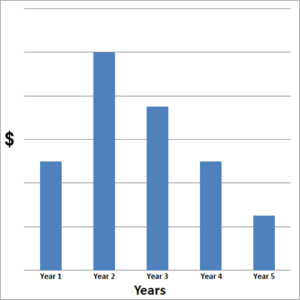This article was created as a resource for club promoters who are trying to enlist the assistance of their members in the task of attracting new members. All of the articles in this series offer suggestions to club members regarding how they can help to attract new members. Club promoters are encouraged to link to it if they wish to provide suggestions to their members.
Why Beginners Matter

As you can imagine, this many people and this many transactions across this many racquet sports leave behind a large amount of data to aggregate. And from this aggregate data, we can draw some interesting conclusions that are beneficial to every type of racquet sports club.
Here is a concrete example of how that data can be used. There are two squash clubs in our part of the city. Both have about the same number of players, both cater to adult males. Club A is closer to us than Club B, so you would expect that Club A would generate more sales for us than Club B. In fact, however, Club B generates more spinoff business for our store than Club A for one simple reason.
Club B is marginally better than Club A at attracting new players. And by that we don’t mean members who are new to Club B; we mean players who are new to playing the game of squash. Or in other words, Club B is better than Club A at attracting and retaining beginners.
Club A is caught in what we call a cycle of high performance failure. They have turned their club over to a volunteer who spends all of his time trying to attract better players from other clubs. He is focussed almost entirely on Club A’s interclub team performance. Therefore, whether he knows it or not, under his leadership, Club A is pursuing a high performance agenda — an agenda that will ultimately fail the club’s shareholders.
Club B, on the other hand, is more open both to new members and new players. They have more to offer than just an opportunity to play on a winning interclub team. They actually have programs and activities that are attractive to beginners who may be two or three years away from having enough confidence to join an interclub squash team.

Each bar represents one year of expenditures for players who are new to the sport. You can see that new players spend as much in their first two years as they do in their next three years combined. In fact, most players spend more in their second year of involvement with a new racquet sport than they do in any other year.
Now think about a club filled with 100 players in Year 5 and beyond (Y5+). If you look at what these players are likely to spend on their sport, you will see that 100 of these guys will spend as much as 20 players in their second year (Y2). So a club with 50 Y5+ members and 50 Y1/Y2 members is in a much stronger position financially than a club with 100 Y5+ members.
Think back to glory days for squash in the 80s and 90s. In those days, clubs could make some money. And in those days, the clubs were full of beginners. As the sport of pickleball is demonstrating across Canada today, clubs that are full of Y1s and Y2s are way better off than clubs full of Y5+ players.
So when we say that Club A is caught in a cycle of failure, it should be clear now what we mean. Success in the club’s interclub standings is coming at the expense of Club A’s bottom line. Fortunately for us, we are not shareholders in Club A. So, unlike the actual shareholders, we can be somewhat clinical about their prospects.
However, we would prefer to see Club A succeed and stay open. Given their proximity to our business, it would be nice to see them regain their footing and move away from a high performance agenda toward a high participation agenda. In fact, we think it would be nice to see every club in Canada now pursuing a high performance agenda move to back to a high participation agenda because that would be good for the clubs and for every retailer and manufacturer who serves these clubs.
